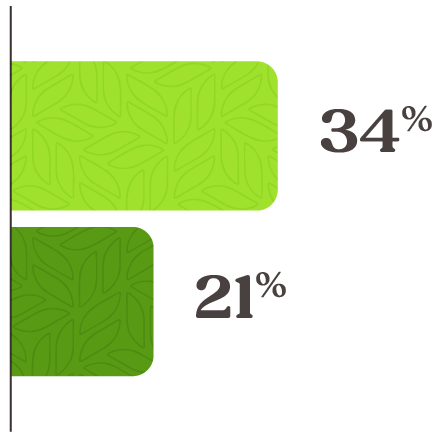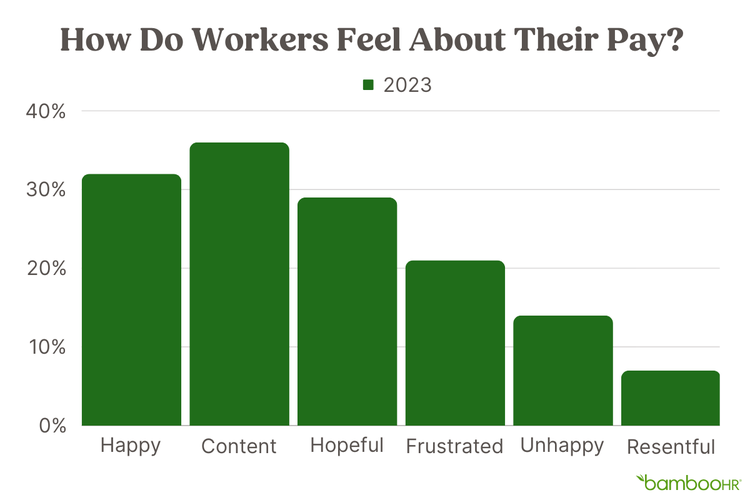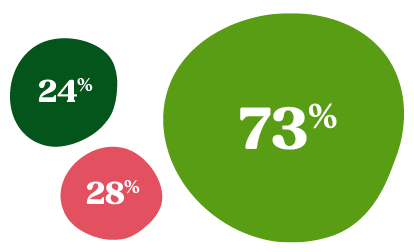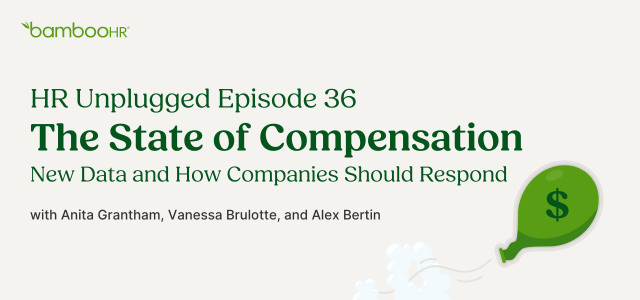
Compensation Trends for 2024: Deflation, Transparency, and Benefits
💡 Compensation Trend Takeaways
- Two in five salaried workers haven't received a salary increase in the past 12 months.
- The average increase for those who did get a raise was 4.6%, lower than the 6.2% average in 2022.
- 21% of salaried workers changed employers in the last year, compared to 34% in 2022.
- 29% of employees don't expect a salary increase or promotion in the next 12 months.
- 27% of women expressed frustration with their compensation, up from 16% in 2022, compared to 15% of men, up from 11% in 2022.
- 44% of employees would stick with a job they disliked if the salary was high enough.
- 24% of workers say they’d be willing to take a salary cut if it meant job security for the next year.
- 28% of employees would take a salary cut for a more flexible working location.
- 73% of employees admitted they would consider leaving their current job for a higher paycheck.


Two in five salaried employees didn’t receive a raise in the last year. For those who did, those raises are 25% less than in 2022.
With the rocky economic climate, morale has taken a hit as salary dissatisfaction has increased, though this impact isn't felt equally across genders. Women are twice as likely (27%) to feel frustrated with their compensation as men (15%).
As layoffs continue across tech, media, and finance, employees are prioritizing job security over pay, choosing to cling to their current jobs rather than enter an uncertain job market.
24% of workers say they’d be willing to take a salary cut if it meant job security for the next year.

BambooHR surveyed 1,500 US full-time salaried employees to better understand employee sentiment and perception of their current compensation and benefits, including:
- How well is compensation keeping up with employee needs and expectations?
- Are employees happy with their current compensation and benefits?
- Which elements of compensation and benefits matter most to employees?
- How often do employees discuss their pay with each other?
Let’s dig into employee perceptions and experiences around compensation and benefits—and what to do about it.
📉 Salary Deflation
While the worst of recent inflation rates may be behind us, it’s still to blame for salary deflation—when rising costs of living decrease purchasing power.
Most employees are focused on cost of living, which is the local cost of goods, services, and housing, while businesses are focused on cost of labor, which is the local cost of a role based on market demands.
In 2023, the US annual inflation rate was 3.3% in October, down from 3.7% in September, which continues to hamper pay despite workforce participation still being well below pre-pandemic levels.

Two in five salaried employees didn’t receive a raise in the last year. For those who did, those raises are 25% less than in 2022. And for those who did get a raise, the average increase was 4.6%. This is down from last year, when the average increase was 6.2% and just one in three workers didn't get raises.
With the turbulent economy and reports of layoffs, fewer workers have been changing jobs in the past year, despite a robust (albeit slowing) job market, where the number of jobs continues to surpass the number of workers.
For those who have made a move, they're not seeing as big of a salary increase as before.
21% of salaried workers changed jobs in the last year, compared to 34% in 2022

For those who did get a pay bump with their job change, the average salary increase was 13.9%, which is nearly half as much as the previous year.
But even though fewer workers are making a job change, almost half (48%) of them have thought about leaving their company in the last six months to find better compensation.
That's up from 41% who felt the same way in 2022—evidence that people are still yearning for greener pastures.
It's clear that inflation and stagnant salaries are taking a toll on employees.
Unhappiness rises when salaries don’t.
Unfortunately, things aren't looking up anytime soon.
29% of employees don't expect any salary increases or promotions in the next 12 months.
Despite 58% of employees feeling positively about their current compensation, nearly one in four employees say they’re dissatisfied with their most recent salary increase, with 30% of employees feeling negatively about their compensation: 21% felt frustrated, while 14% felt downright unhappy.

This echoes BambooHR’s Employee Happiness Index, which shows employee happiness has been in steady decline for three years in a row.
There's also a gender difference when it comes to how employees feel about their pay. 27% of women expressed frustration with their compensation, up from 16% in 2022, compared to 15% of men, up from 11% in 2022.
One interesting note: while higher pay doesn’t instantly make employees happier, it does make them sticky. 44% of employees would stick with a job they disliked if the salary was high enough.
That said, unhappy employees are usually less productive and make more mistakes.
Why higher pay isn’t (always) the answer.
It'd be easy to assume higher wages would be the biggest motivator for employees, given the current economy. However, our findings highlight two notable exceptions:
- 24% of workers say they’d be willing to take a salary cut if it meant job security for the next year.
- 28% of employees would be willing to take a salary cut for a more flexible working location.
But employers should still take heed: 73% of employees admitted they would consider leaving their current job for a higher paycheck.

And the target is slipping: on average, it'd take a 13.3% pay increase to tempt an employee away from their current position, down from 16.1% in 2022.
For employees who made the leap to a new company within the last year, 46% of them received an average pay increase of 13.9%, consistent with what they said they would leave for, but those raises have been cut in half. In 2022, 53% of employees who moved to a new company within the previous two years received an average increase of 27.4%.
It’s worth pointing out that for most, the way to increase pay is to get a different job, as 58% of Americans are apprehensive about asking for a raise, despite retention costs being much cheaper than hiring.
🎈Compensation Advice: Communication Is Key
Business and HR leaders can manage compensation complexity through open, transparent communication. By communicating company policies around benefits, flexibility, and fair compensation, HR managers can create a positive work environment that fosters employee satisfaction and loyalty.
With job security looming large in employees' minds, communicating regularly about the company’s health and direction is key. If there are changes coming, increase the frequency of communication and be upfront about why they need to be made.
Offer work schedule flexibility.
Remember that not all employees are solely motivated by higher pay. Consider that 24% of workers value job security, while 28% desire a more flexible working location. Evaluate offering options like remote work or flexible schedules to meet these needs. Not only is it a competitive hiring and retention play, but flexible work is also tied to revenue growth.
Stay competitive with salary increases.
With 73% of employees considering leaving for a higher paycheck, it's crucial to stay competitive in terms of compensation. Keep an eye on market trends and adjust salaries accordingly to attract and retain top talent. While Business Insider estimates pay raises will be modest for the next few years, giving employees what you can saves you more in the long run, as retention is the number one operational priority for most businesses.
Address dissatisfaction with current compensation.
58% of employees are content or happy with their financial compensation—meaning almost half of the workforce wants better pay. Take time to listen to employee feedback and address concerns they have about their salaries.
Regularly review and adjust compensation packages to ensure they are fair, and align with industry standards and employee expectations, and emphasize the value of employees’ total compensation.
🔍 Salary Transparency
Let's shed some light on pay transparency, a term that often sparks confusion and strong opinions. It's important to understand that employees will continue to discuss their salaries with each other, regardless of how employers define pay transparency.
When it comes to defining salary transparency, there are various perspectives floating around workplaces, which can lead to conflicting opinions. Here's a breakdown of what employees currently think:
- 59% of employees believe salary transparency means clearly communicating the complete compensation package to everyone. This includes not only base salary but also additional benefits and bonuses.
- 50% of employees view salary transparency as the disclosure of salary ranges for every role within the company. This allows employees to have a general understanding of the potential salary they can expect for a particular position.
- 32% of employees believe that true salary transparency involves disclosing the exact salary for each role, not just a salary range, leaving no room for ambiguity or speculation.

It's clear there isn't a one-size-fits-all definition of salary transparency. Employees have varying expectations and opinions on what it entails, which could further evolve as pay transparency laws continue to roll out. As an employer, it's crucial to understand these perspectives and find a balance that aligns with your company culture and values.
Regardless of employees' opinions about salary transparency, it has a significant impact on their decision-making process:

82% of employees consider some form of salary transparency essential when evaluating potential employers, up from 69% in 2022.
An equal number (83%) believe benefits transparency is equally important, compared to 69% in 2022.
This positive attitude on pay transparency is also making its way to the C-suite. In a Glassdoor survey, 55% of senior leaders disagree or strongly disagree with the suggestion that greater pay transparency will make it harder to retain talent.
As more companies are transparent about pay information, it’s becoming less taboo for employees to discuss salaries with each other. 69% of employees feel comfortable discussing their salary with a coworker, with 52% having already engaged in such conversations—45% have done so just in the last year.
And the younger the employee, the more open they are to discussing their salaries. 76% of Gen Z employees have disclosed their salary to a coworker, compared to 60% of Millennials, 39% of Gen X, and 30% of Boomers.
🎈Compensation Advice: Train Managers on Total Rewards
With a topic as complex and emotionally loaded as pay, an ounce of prevention is worth a pound of cure. Employers should encourage open dialogue, making sure employees feel valued and supported in their compensation discussions and that compensation strategies are fair and honest.
Clearly define and communicate your company's approach to salary transparency.
With conflicting opinions and expectations around salary transparency, it's crucial for HR managers to establish a clear definition within their organization. Communicate this definition to employees, making sure everyone understands what salary transparency means in your specific context. This is especially important for businesses with employees in areas where compliance with pay transparency legislation is at play.
This clarity will help manage expectations and avoid confusion. Open communication and transparency are key to ensuring employee satisfaction and engagement when it comes to compensation.
Train managers on effective compensation communication.
Managers play a vital role in fostering transparency and trust within their teams. Provide training and resources to help managers effectively communicate compensation, including how to discuss total compensation packages, explain salary ranges, and address any questions or concerns employees may have.
Ensure that competitive pay decisions are based on objective criteria, such as performance and skills, to promote fairness and minimize disparities.
🎁 Total Compensation and Benefits
Salary is just one element of a total compensation strategy, which includes all other financial benefits an employer provides, like health insurance and PTO. As the world moves further into a bear market, it’s important to keep employees informed of any potential changes in your benefits offering and costs.
56% of employees report that their employers have introduced new or improved benefits, while 28% say their benefits have been removed or reduced.

Some employees have been negatively impacted by employer-driven changes to their healthcare benefits, often without prior notice: 15% of employees have had a benefit they relied on taken away without warning.
And if your company is small enough that benefits aren’t required, that doesn’t mean you’re off the hook: half of employees believe employers who fail to provide essential benefits should compensate their workers more, up from 45% in 2022.
Work-life balance is key for many employees.
When it comes to paying in-office versus remote workers, people generally agree compensation should be the same. The majority (62%) believe both types of workers should be paid equally for the same work.
However, 32% of respondents believe in-office workers should be paid more than remote or hybrid workers, while only 6% think the opposite.

Interestingly, there are some gender differences in these opinions: 36% of men think in-office workers should be paid more, compared to 28% of women.
More women (67%) than men (56%) believe both should be paid equally.
McKinsey offers key insight into why workplace flexibility is so important to women: one in five women attribute workplace flexibility to maintaining their work hours or being able to keep working at all, in addition to feeling less burned out and having increased focus time, particularly if the woman is a mother with young children.
So why do people value in-office work over remote and hybrid work? For the workers who believe in-office workers should be paid more, 77% say it's because they have to spend additional time and money commuting. One-third of respondents also believe in-office workers simply do more work.
On the other side of the spectrum, 69% feel that being in an office sacrifices their work flexibility, and 56% have to deal with the pressures of in-office politics.
🎈Compensation Advice: Reevaluate Your Benefits Offerings
Benefits can be the lever HR managers use to address the evolving needs and expectations of employees, foster a positive work environment, and attract and retain top talent.
Prioritize work-life balance considerations.
Recognize the importance of work-life balance for your employees’ wellbeing. You’ll not only have happier employees but healthier ones, too. Harvard researchers recently found that giving employees more control over their schedules and more support for personal matters improves their heart health.
Consider offering flexible work arrangements, such as remote or hybrid options, to accommodate different preferences and needs. Employee freedom and flexibility foster loyalty, so look for ways to create as much freedom for your employees as your organization can give.
Employee flexibility to choose the work environment they do their best work in can also support DEI efforts. According to SHRM, many workers from underrepresented groups experience fewer microaggressions when working remotely.
Evaluate your compensation structure to ensure fairness between in-office and remote workers, considering factors like commuting costs and work flexibility. If you decide to compensate your in-office, hybrid, and remote workers differently, openly explain the decision and the thinking behind it, as well as how the decision may impact compensation going forward.
» Learn More: Check out our free Total Compensation Calculator to improve how you communicate employee compensation.
Keep communication frequent and transparent.
In times of market fluctuations or benefit offerings changes, it's crucial to keep employees informed. Most employers have taken this tack in response to this year’s economic rollercoaster, with 75% of US employers having increased compensation and benefits communications.
Regularly communicate any potential changes in benefits or costs, providing transparency and clarity. This will help employees understand the value of their total compensation package beyond just salary and feel prepared for what’s ahead.
» Learn More: Make open enrollment a breeze with our Open Enrollment Communications Plan Templates
Evaluate your benefits offering.
Conduct periodic evaluations of your benefits offerings to ensure they align with employee needs and market trends. Consider employee feedback and industry benchmarks to identify areas where you can make improvements. This proactive approach will demonstrate your commitment to providing competitive and valuable total compensation.
About BambooHR
BambooHR® is the leading provider of cloud-based HR software solutions that empower HR professionals to manage, support, and grow what matters most—their people. As a company, BambooHR's mission is to set people free to do great work, by automating, centralizing, and connecting employee data all in one place to support better decisions. The platform’s intuitive and intentionally designed payroll, time tracking, benefits, performance, and reporting solutions support the full repertoire of HR responsibilities—all backed by award-winning customer service. Over the past 15 years, BambooHR has been the trusted partner of HR professionals at 32 thousand companies in over 150 countries and 50 industries in supporting millions of users throughout their employee experience.
Methodology
BambooHR conducted this research using an online survey prepared by Method Research and distributed by RepData among n=1,500 adults (age 18+) in the United States who are full-time salaried employees. The sample was equally split between genders, with a spread of age groups, race groups, and geographies represented. Data was collected from July 27 to August 4, 2023.
Employee Happiness Erodes in Q3 as The Great Gloom Continues
Is the Great Gloom loosening its grip? Not quite. The BambooHR Employee Happiness Index shows employee happiness continues its three-year decline.
First Impressions Are Everything: 44 Days to Make or Break a New Hire
70% of new hires decide whether a job is the right fit within the first month—including 29% who know within the first week. Onboarding makes all the difference.
31% of HR Managers Say They Need Better Employee Data Protection
Discover insights into employee perception and experience with data security—and how to better protect your workforce data.
